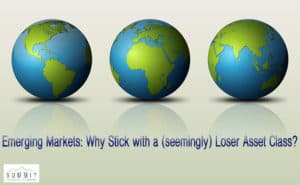
Over the past year I have been asked numerous times why we would not only continue to hold Emerging Markets stocks, but add to those positions when we rebalance portfolios.
Index returns show that Emerging Markets have posted negative returns for four out of the past five years, while the S&P 500 has experienced positive returns each of those same five years. To further illuminate the discrepancy of returns:
|
2015 Return |
5 Year Annualized Return | |
| MSCI Emerging Markets Index | -14.6% | -4.5% |
| S&P 500 Index | 1.4% | 12.6% |
That is a very wide discrepancy in returns.
The short answer as to why we would continue to hold and add to that position is that asset classes cycle in and out of good and bad performance and it is unpredictable when those cycles will begin and end. But we need to look at the much bigger picture to appreciate just how valuable holding onto a seemingly loser asset class is as part of a globally diversified portfolio is in an investors best interest.
If we look at the 28 year period of 1988 to 2015, the time period for which we have Emerging Markets Index Data, Emerging Markets had negative returns for 13 of those 28 years. Conversely, the S&P 500 had negative annual returns for only five of those years. Which asset class do you think would have been the better place to invest? The S&P 500, right? Naturally one would think that! The reality is that the S&P 500 returned an average of 10.3% per year during those 28 years, and if you had invested $100,000 at the beginning of that period, your investment would be worth $150,500 today. Not bad! However, even with those multiple years of horrible returns, the total return for Emerging Markets was 10.5% per year, and the same $100,000 would have grown to $163,000. Completely counterintuitive!
Let’s look at another example when owning such a highly volatile and sometimes discouraging asset class can pay off. The 10 year period of 2000-2009 is sometimes known as the ”Lost Decade,” because the S&P returned -0.9% per year for that period. If you had invested $100,000 at the beginning of 2000, your investment would be worth $90,000 at the end of 2009. Pretty discouraging! Conversely, an investment in Emerging Markets would have returned 10.1% annually for the same period, and your $100,000 would have grown to $260,000.
Was any of this predictable? No, and it never will be. The question is, are you willing to stay the course when the future looks uncertain? Are you willing to hang on for the ride even when you are feeling motion sick?
Investing in a thoughtful methodology of owning a portfolio that owns stocks in companies from all over the world may at times look like you are the turtle in the race because you are hanging on to what currently seems to be loser investments and the rest of the world in running with the hares, but it gives you the greatest possibility of winning the race of your own investment success.
Interestingly, the S&P 500 has returned 3.01% so far this year (as of 4/26/2016) while the MSCI Emerging Markets Index’s performance is 6.65% Year to Date. Will this be one of the good years for Emerging Markets? I am hopeful that it is, but there is no way to know. That being said, I would not want to be missing from the party if it is.

